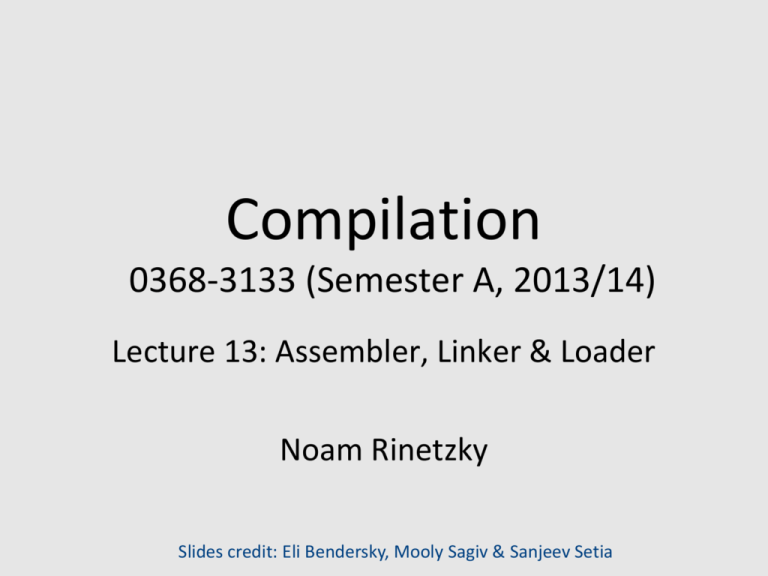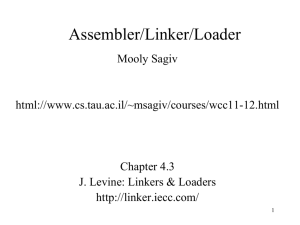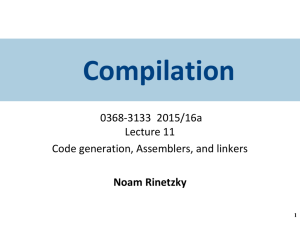Lecture 13
advertisement

Compilation 0368-3133 (Semester A, 2013/14) Lecture 13: Assembler, Linker & Loader Noam Rinetzky Slides credit: Eli Bendersky, Mooly Sagiv & Sanjeev Setia What is a compiler? “A compiler is a computer program that transforms source code written in a programming language (source language) into another language (target language). The most common reason for wanting to transform source code is to create an executable program.” --Wikipedia Stages of compilation Source code Lexical Analysis Syntax Analysis Context Analysis Portable/Retarg etable code generation Parsing Code Generation Target code (executable) Assembly IR AST + Sym. Tab. AST Token stream Text (program) Compilation Execution Source code Lexical Analysis Syntax Analysis Context Analysis Portable/Retarg etable code generation Parsing Code Generation Executing Target code program (executable) Runtime System image Loader IR Linker Object File Executable File Assembler AST + Sym. Tab. Symbolic Addr AST Token stream Text (program) Program Runtime State Registers 0x11000 foo, extern_foo printf 0x22000 G, extern_G 0x33000 Code Static Data x Stack 0x88000 Heap 0x99000 Challenges • • • • • • goto L2 JMP 0x110FF G:=3 MOV 0x2200F, 0..011 foo() CALL 0x130FF extern_G := 1 MOV 0x2400F, 0..01 extern_foo() CALL 0x140FF printf() CALL 0x150FF 0x11000 foo, extern_foo printf 0x22000 G, extern_G 0x33000 x 0x88000 • x:=2 MOV FP+32, 0…010 • goto L2 JMP [PC +] 0x000FF 0x99000 Code Static Data Stack Heap Assembly Image Source program Compiler Assembly lang. program (.s) Assembler Machine lang. Module (.o): program (+library) modules Linker “compilation” time Executable (“.exe”): “execution” time Loader Image (in memory): Libraries (.o) (dynamic loading) Outline • Assembly • Linker / Link editor • Loader • Static linking • Dynamic linking Assembly Image Source file (e.g., utils) Source file (e.g., main) library Compiler Compiler Compiler Assembly (.s) Assembly (.s) Assembly (.s) Assembler Assembler Assembler Object (.o) Object (.o) Linker Executable (“.elf”) Loader Image (in memory): Object (.o) Assembler • Converts (symbolic) assembler to binary (object) code • Object files contain a combination of machine instructions, data, and information needed to place instructions properly in memory – Yet another(simple) compiler • One-to one translation • Converts constants to machine repr. (30…011) • Resolve internal references • Records info for code & data relocation Object File Format Header • • • • Text Segment Data Segment Relocation Information Symbol Table Debugging Information Header: Admin info + “file map” Text seg.: machine instruction Data seg.: (Initialized) data in machine format Relocation info: instructions and data that depend on absolute addresses • Symbol table: “exported” references + unresolved references Handling Internal Addresses Resolving Internal Addresses • Two scans of the code – Construct a table label address – Replace labels with values • One scan of the code (Backpatching) – Simultaneously construct the table and resolve symbolic addresses • Maintains list of unresolved labels – Useful beyond assemblers Backpatching Handling External Addresses • Record symbol table in “external” table – Exported (defined) symbols • G, foo() – Imported (required) symbols • Extern_G, extern_bar(), printf() • Relocation bits – Mark instructions that depend on absolute (fixed) addresses • Instructions using globals, Example External references resolved by the Linker using the relocation info. Example of External Symbol Table Assembler Summary • Converts symbolic machine code to binary – addl %edx, %ecx 000 0001 11 010 001 = 01 D1 (Hex) • Format conversions – 3 0x0..011 or 0x000000110…0 • Resolves internal addresses • Some assemblers support overloading – Different opcodes based on types Linker • Merges object files to an executable – Enables separate compilation • Combine memory layouts of object modules – Links program calls to library routines • printf(), malloc() – Relocates instructions by adjusting absolute references – Resolves references among files Linker 0 100 200 0 300 450 foo ext_bar() Code Segment 1 Data 100 120 Segment 1 Code Segment 2 400 ext_bar 150 zoo 180 Data Segment 2 0 500 Code Segment 1 Code Segment 2 Data ext_bar zoo 250 280 420 Segment 1 Data 650 Segment 2 380 foo 580 Relocation information • Information needed to change addresses • Positions in the code which contains addresses – Data – Code • Two implementations – Bitmap – Linked-lists External References • The code may include references to external names (identifiers) – Library calls – External data • Stored in external symbol table Example of External Symbol Table Example Linker (Summary) • Merge several executables – Resolve external references – Relocate addresses • User mode • Provided by the operating system – But can be specific for the compiler • More secure code • Better error diagnosis Linker Design Issues • Merges – – – – Code segments Data segments Relocation bit maps External symbol tables • Retain information about static length • Real life complications – – – – Aggregate initializations Object file formats Large library Efficient search procedures Loader • Brings an executable file from disk into memory and starts it running – Read executable file’s header to determine the size of text and data segments – Create a new address space for the program – Copies instructions and data into memory – Copies arguments passed to the program on the stack • Initializes the machine registers including the stack ptr • Jumps to a startup routine that copies the program’s arguments from the stack to registers and calls the program’s main routine Program Loading 0 Registers Code Segment Static Data Stack Heap Loader Image 100 400 500 Code Segment 1 foo Code Segment 2 ext_bar zoo Data 250 280 420 Segment 1 Data 650 Segment 2 Program Executable 580 Loader (Summary) • Initializes the runtime state • Part of the operating system – Privileged mode • Does not depend on the programming language • “Invisible activation record” Static Linking (Recap) • Assembler generates binary code – Unresolved addresses – Relocatable addresses • Linker generates executable code • Loader generates runtime states (images) Dynamic Linking • Why dynamic linking? – Shared libraries • Save space • Consistency – Dynamic loading • Load on demand What’s the challenge? Source program Compiler Assembly lang. program (.s) Assembler Machine lang. Module (.o): program (+library) modules Linker “compilation” time Executable (“.exe”): “execution” time Loader Image (in memory): Libraries (.o) (dynamic linking) Position-Independent Code (PIC) • Code which does not need to be changed regardless of the address in which it is loaded – Enable loading the same object file at different addresses • Thus, shared libraries and dynamic loading • “Good” instructions for PIC: use relative addresses – relative jumps – reference to activation records • “Bad” instructions for : use fixed addresses – Accessing global and static data – Procedure calls • Where are the library procedures located? How? “All problems in computer science can be solved by another level of indirection" Butler Lampson PIC: The Main Idea • Keep the global data in a table • Refer to all data relative to the designated register Per-Routine Pointer Table • Record for every routine in a table &foo &D.S. 1 &D.S. 2 PT ext_bar &ext_bar &D.S. 2 foo Code Segment 1 Code Segment 2 foo ext_g ext_bar zoo Data Segment 1 &zoo &D.S. 2 PT ext_bar Data Segment 2 580 Per-Routine Pointer Table • Record for every routine in a table • Record used as a address to procedure Caller: 1. Load Pointer table address into RP 2. Load Code address from 0(RP) into RC 3. Call via RC RP Callee: 1. RP points to pointer table 2. Table has addresses of pointer table for subprocedures .func Other data PIC: The Main Idea • Keep the global data in a table • Refer to all data relative to the designated register • Efficiency: use a register to point to the beginning of the table – Troublesome in CISC machines ELF-Position Independent Code • Executable and Linkable code Format – Introduced in Unix System V • Observation – Executable consists of code followed by data – The offset of the data from the beginning of the code is known at compile-time XX0000 Code Segment call L2 L2: Data Segment GOT (Global Offset Table) popl %ebx addl $_GOT[.-..L2], %ebx ELF: Accessing global data ELF: Calling Procedures (before 1st call) ELF: Calling Procedures (after 1st call) PIC benefits and costs • Enable loading w/o relocation • Share memory locations among processes • Data segment may need to be reloaded • GOT can be large • More runtime overhead • More space overhead Shared Libraries • Heavily used libraries • Significant code space – 5-10 Mega for print – Significant disk space – Significant memory space • Can be saved by sharing the same code • Enforce consistency • But introduces some overhead • Can be implemented either with static or dynamic loading Content of ELF file Call PLT Routine PLT GOT GOT Text Libraries Data Data Text Program Consistency • How to guarantee that the code/library used the “right” library version Loading Dynamically Linked Programs • Start the dynamic linker • Find the libraries • Initialization – Resolve symbols – GOT • Typically small – Library specific initialization • Lazy procedure linkage Microsoft Dynamic Libraries (DLL) • Similar to ELF • Somewhat simpler • Require compiler support to address dynamic libraries • Programs and DLL are Portable Executable (PE) • Each application has it own address • Supports lazy bindings Dynamic Linking Approaches • Unix/ELF uses a single name space space and MS/PE uses several name spaces • ELF executable lists the names of symbols and libraries it needs • PE file lists the libraries to import from other libraries • ELF is more flexible • PE is more efficient Costs of dynamic loading • Load time relocation of libraries • Load time resolution of libraries and executable • Overhead from PIC prolog • Overhead from indirect addressing • Reserved registers Summary • Code generation yields code which is still far from executable – Delegate to existing assembler • Assembler translates symbolic instructions into binary and creates relocation bits • Linker creates executable from several files produced by the assembly • Loader creates an image from executable


![Object file formats[edit]](http://s3.studylib.net/store/data/006618103_1-4b9ad58013b9bee33784180bfe3f7f58-300x300.png)




